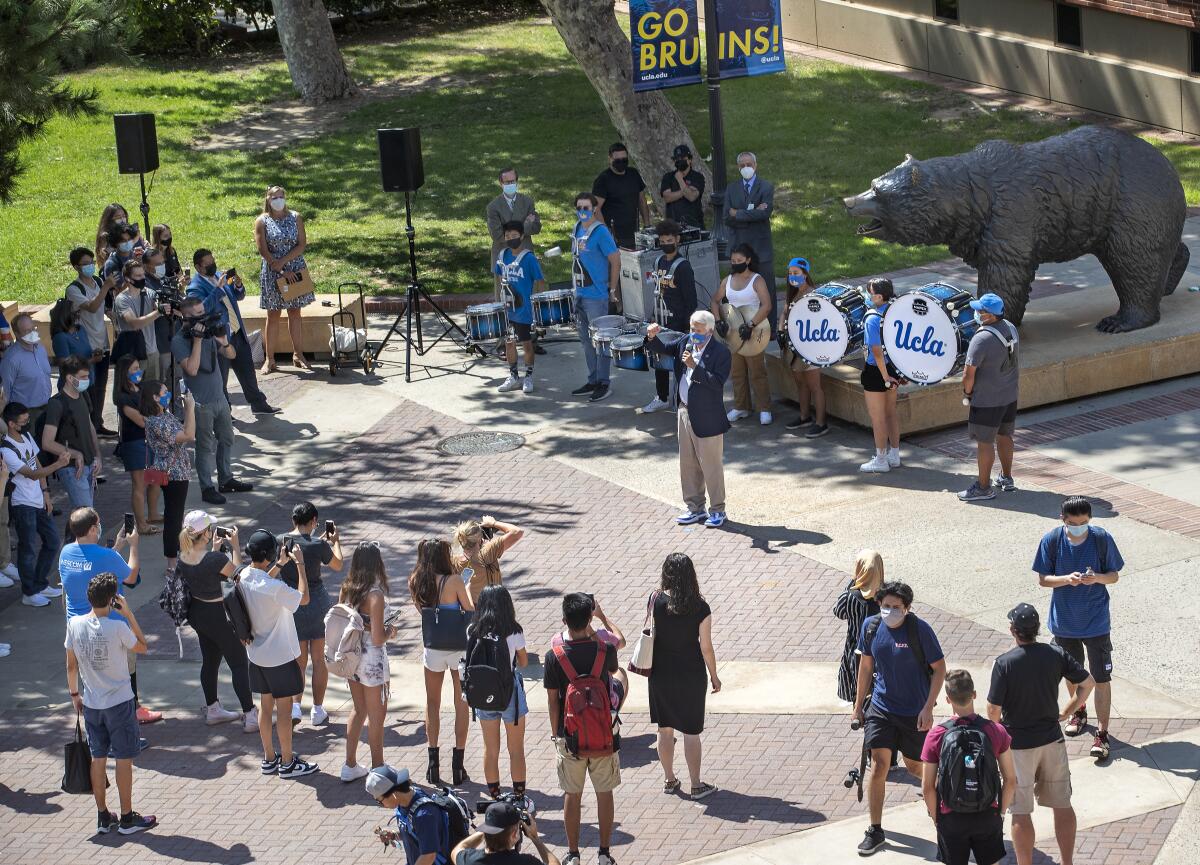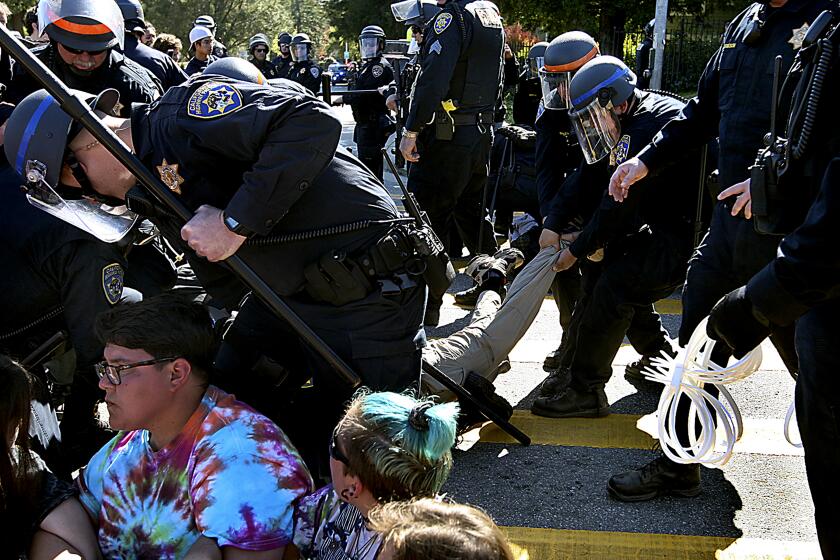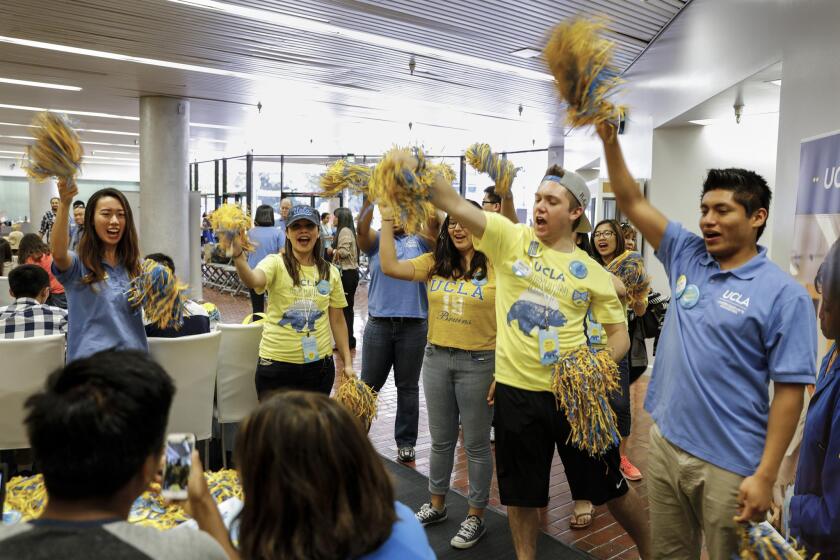UC could add 20,000 seats for students by 2030 to meet surging enrollment demand

- Share via
The University of California is seeking to add 20,000 seats for students by 2030, the equivalent of a new campus, to help meet surging demand for a UC education and college graduates to fill the state’s growing need for highly skilled employees.
UC Board of Regents Chair Cecilia Estolano, who has marked enrollment expansion as one of her top priorities, emphasized, along with UC President Michael V. Drake, that UC must grow without sacrificing its renowned quality in teaching and research and increase numbers of both undergraduates and graduate students, faculty and staff.
The system’s nine undergraduate campuses face a looming capacity crisis that could deprive as many as 144,000 qualified California students a seat at a four-year campus by the end of the decade.
“The demand for, and the value of a UC education has only grown over the years,” Drake said. “Record-breaking application numbers speak for themselves, as do the stories we’ve all heard over the years about the challenges students face in achieving acceptance to the university’s campuses. It’s clear that enrollment growth is essential to the future of the university and the state.”
Last year, UC received an all-time record 250,000 applications for fall 2021 — 203,700 aspiring freshman and 46,155 transfer students — from the most diverse student pool ever. But the system was not able to fully accommodate the increased demand. Admission rates fell, particularly at the most popular campuses, causing widespread angst among families and political pressure to increase enrollment for Californians.
State lawmakers have pledged funding to add 6,200 more UC seats for fall 2022 and to reduce nonresident students at UCLA, UC Berkeley and UC San Diego over five years to make room for 4,500 more Californians. How UC would fund the 20,000-student enrollment increase was not discussed Thursday.
University of California President Michael V. Drake unveiled a plan to post more police data, create independent accountability boards and potentially reallocate some duties and budget dollars from police to community safety specialists.
Pamela Brown, UC vice president for institutional research and academic planning, said despite projections of a demographic decline in the number of high school students, demand for UC seats continues to rise because more of them are graduating and completing the sequence of college preparatory courses required for UC admission. She added that growth is particularly strong among Latinos, who make up more than half of the state’s high school students.
But boosting enrollment is a complicated task for campuses with limited space, resources and conflicting political pressures.
Student regent Alexis Atsilvsgi Zaragoza, for instance, noted that current students are struggling to find affordable housing, access to courses needed to graduate on time and financial aid for summer courses to expedite progress toward a degree. Some campuses, such as UC Santa Barbara and UC Merced, ran so short of housing this fall they are temporarily putting up students in hotels — which Zaragoza called a “huge red flag.”
“We don’t even have capacity to take care of our current students,” Zaragoza said. “We really need to fix the current problems that are directly in front of us.”
Campuses also are caught between pressure to boost enrollment and community objections to sprawling growth and impacts on local traffic, housing and resources.
UC Santa Cruz, for instance, won the regents’ approval Thursday for a long-range development plan that envisions a 44% increase in enrollment by 2040, from 19,000 to 28,000 students. Local opponents say that growth will worsen the area’s housing crunch. Yet a UC Santa Cruz plan to add 3,000 beds has been blocked by litigation over environmental concerns.
A space crunch is projected to intensify in coming years just as the need for highly skilled workers in California grows.
UC Berkeley agreed to limit campus growth of undergraduates to 1% annually under its long-range development plan after the city and neighbors voiced opposition to the impact on the community of more students.
As a result, the Berkeley campus has begun exploring unconventional ways to increase enrollment without adding more students to the physical campus. UC Berkeley Chancellor Carol Christ presented some of those plans to the regents, including a satellite campus at Moffett Field owned by NASA that would focus on aerospace science and engineering. She said satellite campuses were most effective if they offered a specialized focus.
Christ also suggested that UC explore potential mergers with colleges that may be struggling with under-enrollment and financial distress. She noted that Stanford University announced this week that it intended to buy the Belmont campus of Notre Dame de Namur University, a small Catholic institution founded in 1851. The deal will give Stanford space to expand its educational programs while aiding the struggling Notre Dame campus.
Earlier this year, Mills College — a private women’s liberal arts college in East Oakland — agreed to merge with Northeastern University in Boston to jointly develop new academic programs.
Christ added that Berkeley was also working on ways to help students graduate faster, offer more summer sessions and take some classes abroad or online.
“Enrollment growth is central to our strategic planning, but the constraints we have both in the physical footprint of our campus and our agreements with the city of Berkeley mean that we have to look at other ways of growing capacity,” she said.
UC Riverside Chancellor Kim Wilcox said his campus has grown by 24%, from 21,000 to 26,000, since he arrived in 2013 but he would like to see it reach the level of at least 40,000 — the range of UCLA and UC Berkeley. He said increasing tenure-track faculty has been a top priority, which has helped the campus double its research funding and provide students with access to top scholars.
But Riverside is “woefully behind” in adding more staff, he said. The campus, which educates a high share of underserved students, lacks many essential services at the same level of its peers, such as transfer student support, counseling and academic advising.
Unlike UCLA and UC Berkeley, which lack space to expand their physical footprint, UC Riverside still has room to grow and is adding housing complexes and classrooms.
“We’ll grow as fast as resources allow us to grow,” Wilcox said.
One key focus is the pressing need to add more graduate students, who serve as teaching assistants, future faculty and researchers that help drive UC’s global research prowess.
Among the system’s campuses, only UCLA and UC Berkeley enroll graduate students at rough parity to public peers of comparable size. But they fall behind private institutions — at USC, for instance, graduate students make up 58.4% of total enrollment compared to 28.9% at UCLA.
Several regents stressed the need to grow enrollment in an equitable way, drawing students who are representative of not only the state’s diverse racial and ethnic groups but also geographical regions such as the Central Valley and Inland Empire.
Drake, who has convened a working group of chancellors and other UC leaders to develop an enrollment growth plan, said he shared that goal.
“There’s no greater priority for the University of California than our responsibility to build a bridge toward a future where opportunity, like talent, is distributed more fairly across the ZIP Codes,” he said.
More to Read
Sign up for Essential California
The most important California stories and recommendations in your inbox every morning.
You may occasionally receive promotional content from the Los Angeles Times.













